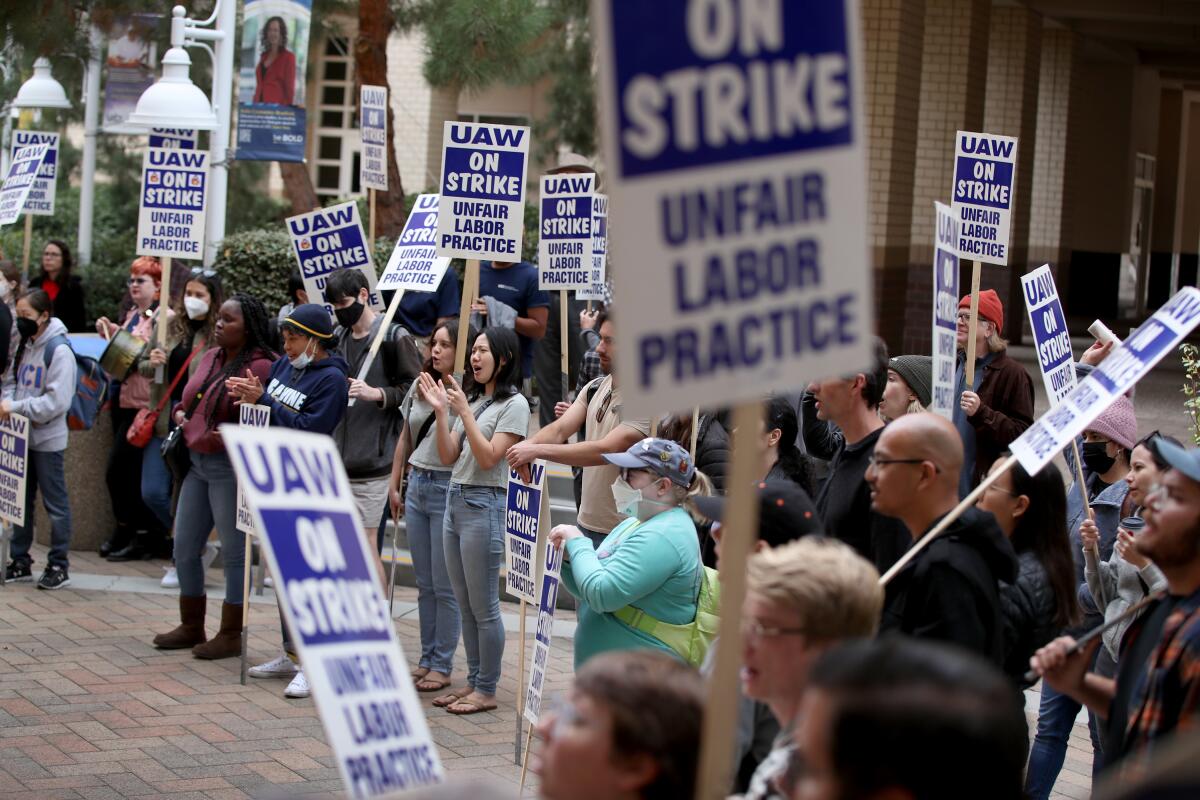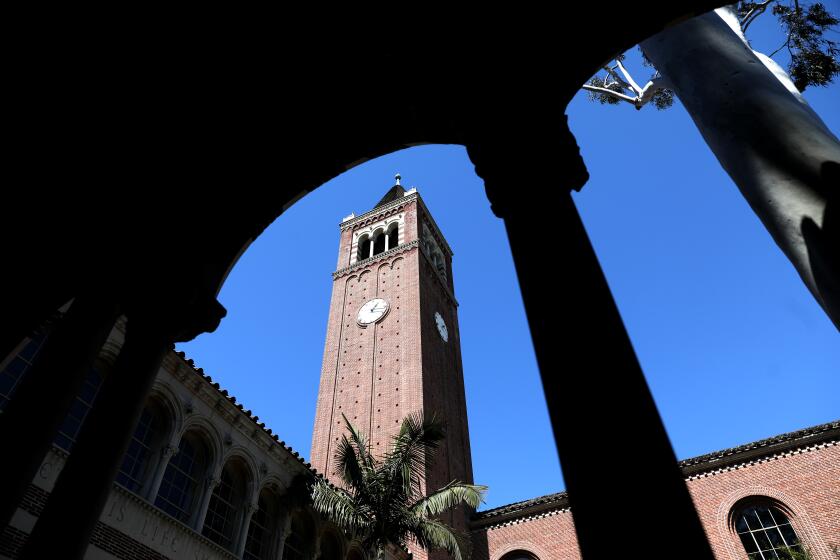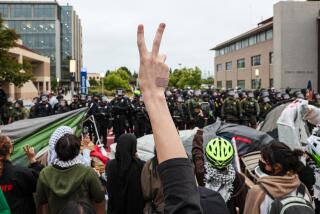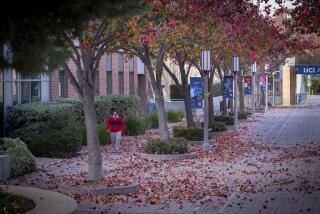‘Time is running out.’ University unions rush to organize before the Trump White House

- Share via
- A flurry of university union activity is unfolding ahead of President-elect Donald Trump’s inauguration.
- Part-time and non-tenure track faculty at USC have filed for a union election to represent roughly 2,500 workers.
Two years after 48,000 University of California academic workers won big pay gains in a historic six-week strike, labor experts and organizers predicted that their success, along with a labor-friendly Biden administration, would spur broad union activism within higher education institutions.
A flurry of recent university union activity coupled with fears of a more pro-business, anti-labor Trump White House is providing the answer. At campuses across the country — including top California universities, New York University and Harvard — unions representing graduate student workers, part-time and non-tenure track faculty and others are rapidly and aggressively moving to organize workers.
For many part-time and non-tenured faculty, who are a backbone of undergraduate education, the union activism reflects their longtime frustrations as lower paid and easily let-go instructors, experts said. Now, time is of the essence.
USC is among several colleges that have issued advisories to international students ahead of President-elect Donald Trump’s Jan. 20 inauguration, telling them to return to campus before he takes office.
“It’s the pre-Trump rush,” said John Logan, a professor in the department of labor and employment studies at San Francisco State University, as unions anticipate new conservative appointees taking over positions in the federal agency that enforces U.S. labor laws. Unions, he said, “are thriving on campuses.”
At USC, a majority of the 2,500 adjunct, part-time and full-time non-tenure track faculty last week said they had signed union authorization cards and filed a petition with the National Labor Relations Board for an election, with hopes that votes will be certified before Inauguration Day.
Trump nominated Linda McMahon for secretary of Education, despite her limited experience in school management. He lauded her support of ‘school choice’ and ‘parents’ rights.’
In Burbank, nearly 200 faculty members at the New York Film Academy’s Los Angeles campus voted this month to form a union. At the California Institute of the Arts in Santa Clarita, a majority of the more than 600 full-time and part-time faculty and staff have signed union authorization cards, though there has not yet been an election.
“We don’t know what Trump is going to do,” said Nadia Suryawinata, a union leader at Caltech in Pasadena, where 2,000 graduate student workers and postdoctoral scholars formed a union in February and overwhelmingly voted this month to authorize their leadership to call a strike — a tactic to speed up negotiations to secure a contract.
“Time is running out. We want a contract by inauguration,” said Suryawinata, a doctoral student in biology who teaches classes and conducts research.
University unions grow
Many of the campuses are organizing with United Auto Workers, the union with origins in car manufacturing whose ranks have increasingly become filled with academics. Campus unions now represent a quarter of the roughly 400,000 UAW members, including graduate-student workers and postdoctoral researchers at the University of California, Caltech, USC and Cal State. UAW is also part of the non-tenured faculty union drive at USC and efforts at CalArts.
A September report from the National Center for the Study of Collective Bargaining in Higher Education and the Professions at Hunter College found that both student worker and faculty unions are growing — with students labor movements moving at a faster clip.
Between 2012 and 2023, the number of unionized graduate student and postdoctoral workers more than doubled, from roughly 64,000 to 150,000. Faculty unions also increased by 7%, from 374,000 to 402,000, in the same period, the report said.
Trump’s presidential term could bring sweeping changes to financial aid, impact UC research funding and eliminate protections for LGBTQ+ and undocumented students.
Today, more than a third of graduate-student and postdoctoral workers are unionized while a quarter of faculty are.
“Among faculty, the drive for unionization has been strongest among non-tenure track faculty,” said William A. Herbert, the executive director of the center who was co-author of the report. “This reflects the massive restructuring of faculty, over the past decades, to largely precarious low-wage college teaching and researching positions.”
“Both groups are a cheap, disposable labor force for universities, and they are feeling the same pressures as everyone else who is working and trying to pay the bills,” said Logan, the SFSU labor studies professor. “Some universities will pay adjuncts about $5,000 a semester per class.”
In California, the biggest fight is expected at USC, where the potential new union called United Faculty-UAW would represent around a third of all faculty. Organizers filed with the National Labor Relations Board on Tuesday. The union would cover eligible employees at all USC schools except for the School of Cinematic Arts, where a separate adjunct faculty union formed in February, and the Keck School of Medicine. No election date is set.
The UC union of academic workers that struck in 2022, UAW 4811, recently averted a clash when membership voted to extend its contract by six months in exchange for 4% raises next October and “transitional funding programs” at each of the University of California campuses.

The funding program, piloted at UCLA this year, allows graduate-student researchers who have had breakdowns in relations with their advisors or have reservations about their funding sources — such as opposition to work tied to the U.S. military or weapons research, an issue that arose during pro-Palestinian protests — to transition away from their current positions.
At UCLA, union members must demonstrate “incompatibility in research goals, or irresolvable differences in the adviser-advisee relationship” to move to new advisors.
Girding for battle at USC
Pay is at the center of union organizing at USC, where non-tenure track professors complain of semester-to-semester contracts with little job security, minimal or nonexistent raises and moves by the university to cut benefits. Current openings for part-time roles at USC on its website list jobs with pay as low as $29.06 an hour in the case of an opening for an adjunct instructor of health policy and management in the Sol Price School of Public Policy.
Several faculty interviewed by The Times also cited cuts to tuition benefits for children and spouses of faculty as a reason they supported unionizing in hopes of having a bigger say in benefit decisions.
“The cost of living is enormous in Los Angeles and keeps on going up, but USC hasn’t been able to keep up,” said Sanjay Madhav, a unionization supporter in the USC Viterbi engineering school who has been a full-time non-tenure track associate professor at the school for 13 years.
Patrick Corbin, an full-time, non-tenure track associate professor in the USC Glorya Kaufman School of Dance, pointed to a COVID-era university decision as among the issues that led him to want a union.
The unique demands made by UC academic workers union have labor experts debating over how the widely watched strike could come to an end.
Amid widespread cost-cutting and a national economic slump, “USC unilaterally froze their contributions to our retirement benefits,” Corbin said. “I wasn’t asked about that. I did not take a vote on it. I’m 60. I cannot get that loss back.”
In a statement, USC said it opposes the union because the administration believes all faculty are managers as a result of being able to vote for Academic Senate officers and serve in other positions that make recommendations on how the campus runs.
“USC respects the role of unions and has worked collaboratively with them for many years. But we have serious concerns — legal, academic, and operational — about a union purporting to represent almost all of our research, teaching, practitioner, and clinical faculty. All of our faculty have an equal voice, and exercise it regularly, in our system of shared governance over how the university operates,” the statement said.
“We do not believe our faculty need a union to speak for them or that applicable law will permit it. We look forward to continuing to work, as we always have, in direct collaboration with our faculty on matters of importance to our university.”
Union organizers argue that playing nonbinding advisory roles on campus is far different from being in management. As an example, they point to a recommendation the Academic Senate made in 2022 that USC implement an annual cost-of-living salary increase. The university rejected the idea.
An attempt to organize some of the same non-tenure track faculty in 2015 and 2016 under the Service Employees Industrial Union fizzled out. Faculty at Dornsife College of Letters, Arts and Science voted against unionization, but union supporters argued USC interfered with the process. Those at the Roski School of Art and Design voted in favor of unionizing. USC sued in multiple court cases over the legality of the Roski election and, by 2019, the SEIU withdrew its petition to represent faculty.
“Back then, it felt like it was a very top-down approach by the SEIU. I wasn’t involved, but I knew it was happening,” said Scott Uriu, who has taught part time in the USC School of Architecture for 14 years and supports unionization. “Today it feels much more like a groundswell.”
More to Read
Sign up for Essential California
The most important California stories and recommendations in your inbox every morning.
You may occasionally receive promotional content from the Los Angeles Times.















